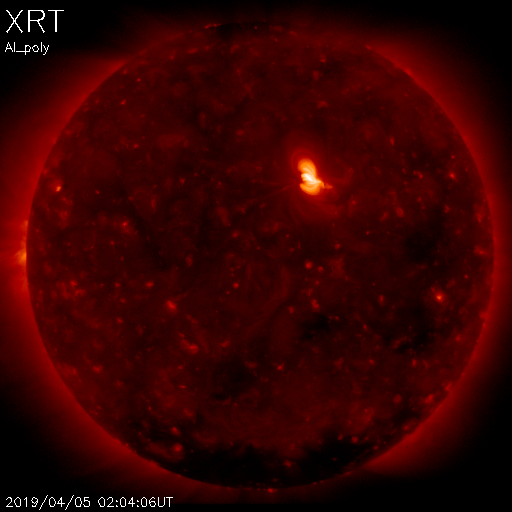
|
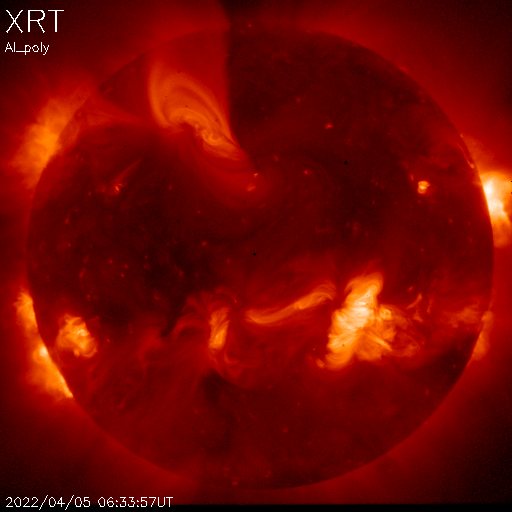
|
| (Quiet Sun) | (Active Sun) |
The current XRT irradiance study is performed by collecting the intensity from the Sun included within 1.1 solar radiai. However, the Sun's emission obviously extends over the outer area. The purpose of this study is to estimate how much energy is uncounted by the limited FOV.
| XOB#1CE4 for high NE-corona obs. [click to enlarge] |
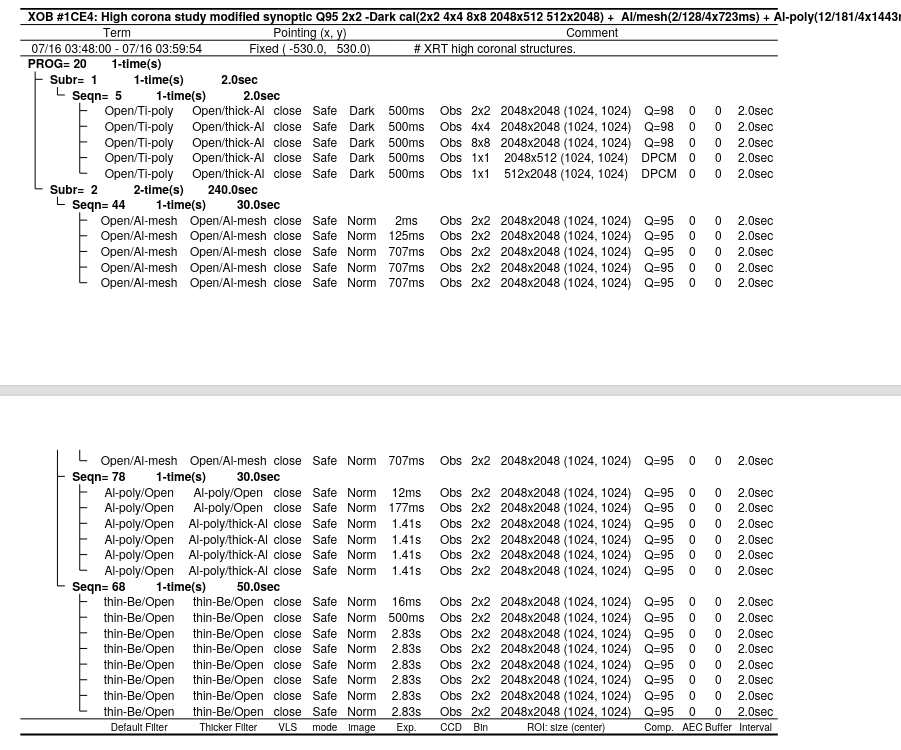
|
| XOB#1CDC for stray light measurements. |
The stray light component was then subtracted from the Al_mesh and Al_poly composite images, while for thin_Be filter the stray light component is still negligible.
| Al_mesh composite image | Al_poly composite image | thin_Be composite image |
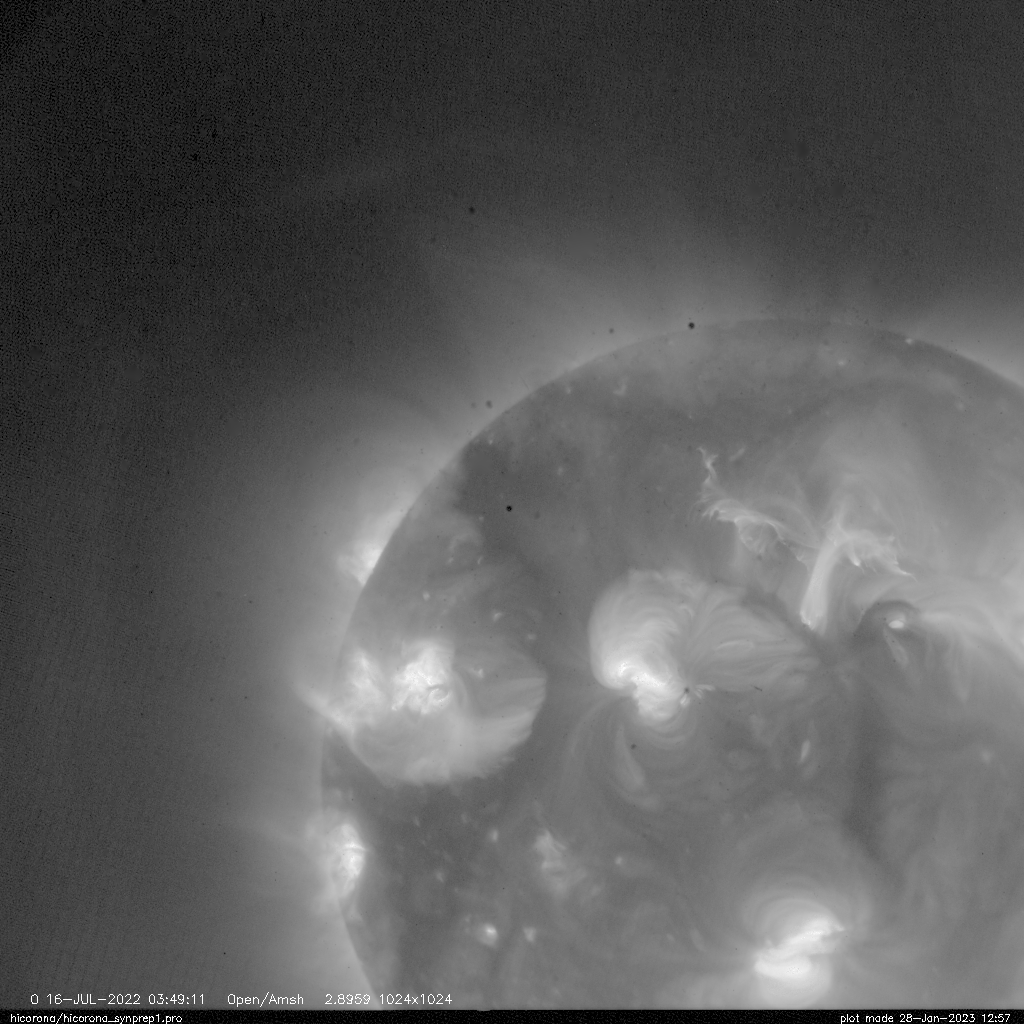
|
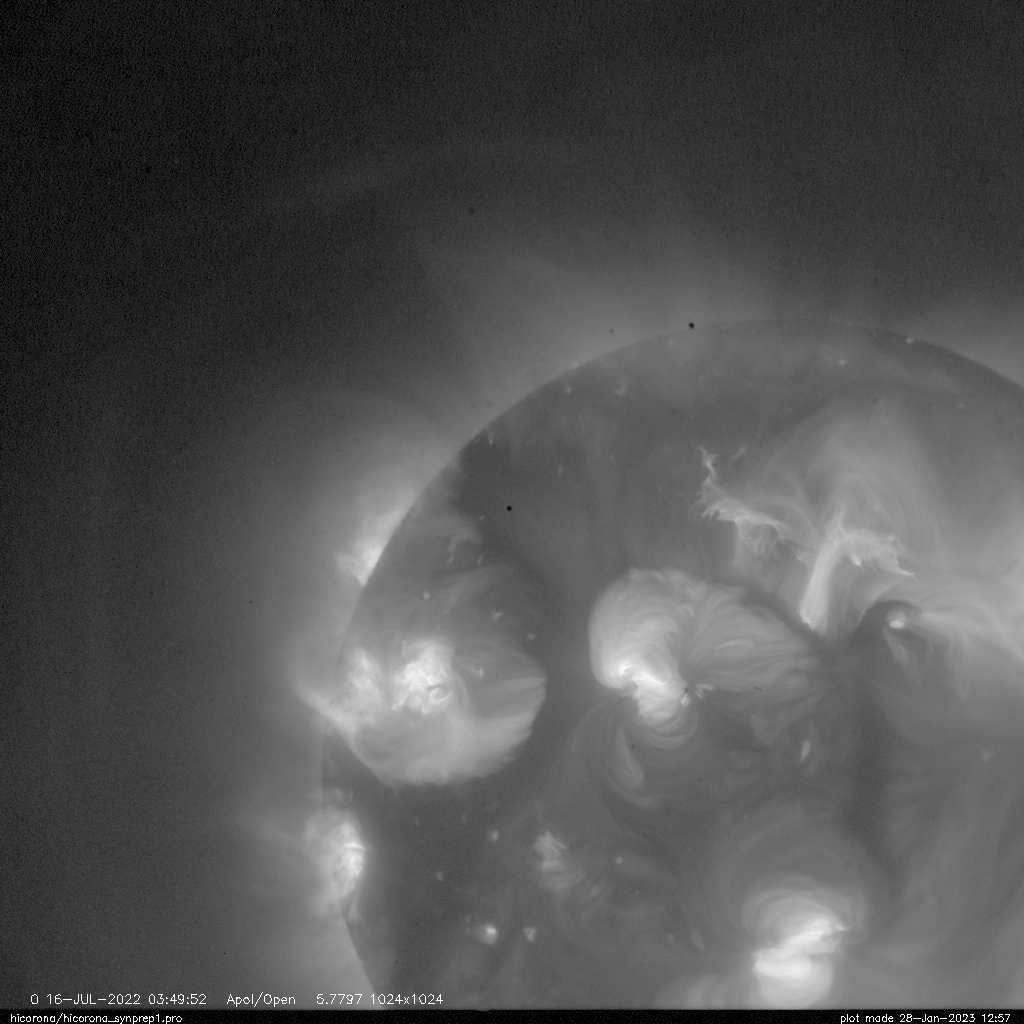
|
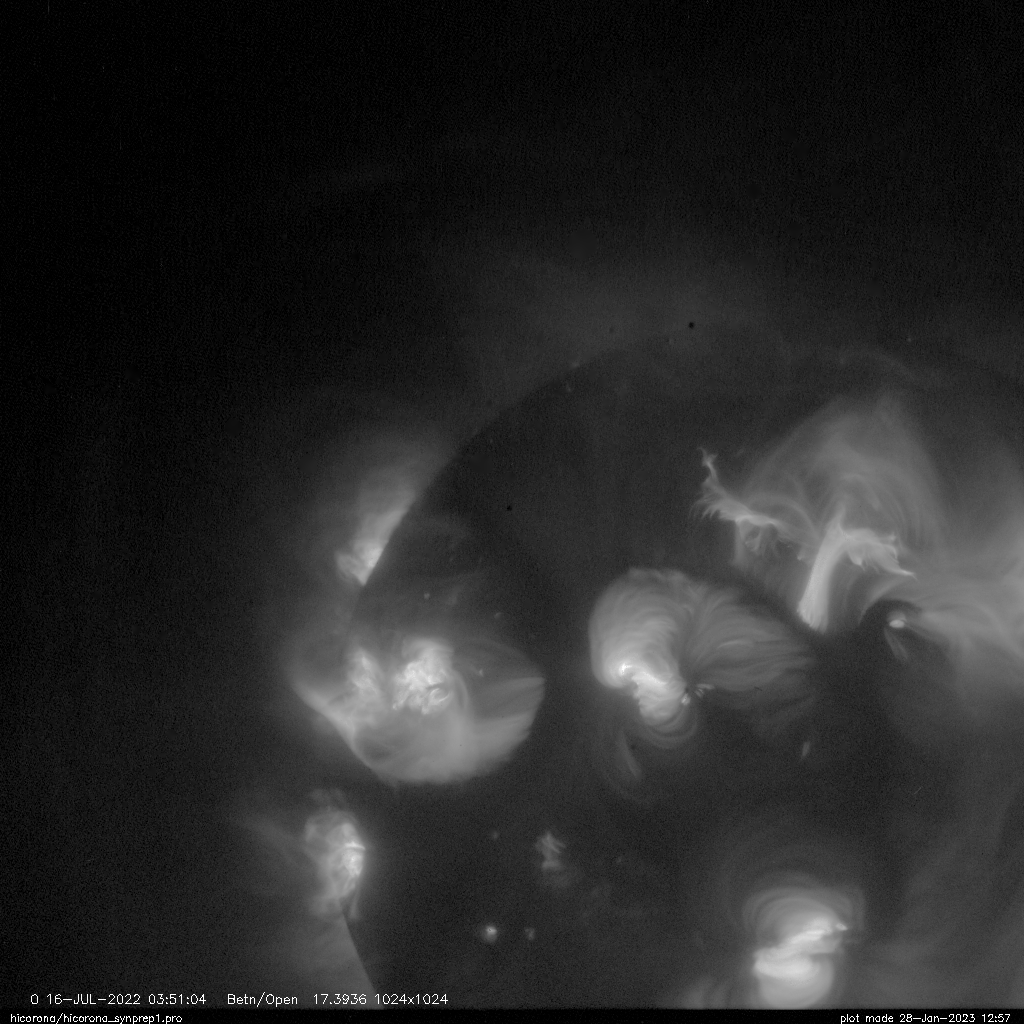
|
| Al_mesh stray light img subtracted | Al_poly stray light img subtracted | --- |
NOTE:
XRT pointing in Heliocentric coordinates (in arcsec). coronal image (2022/07/16): (-555.8, 551.3) stray light image (2022/07/19): (-555.9, 549.1)
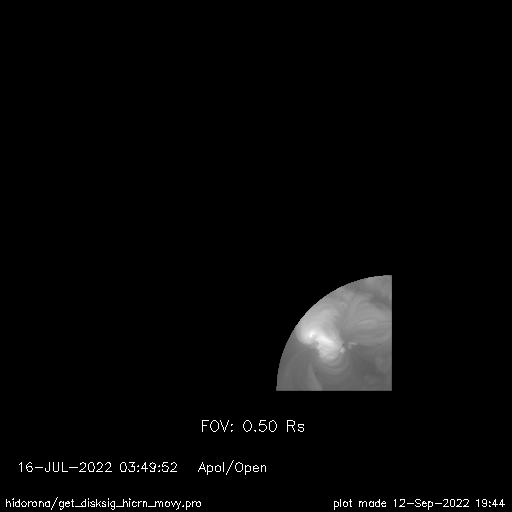 |
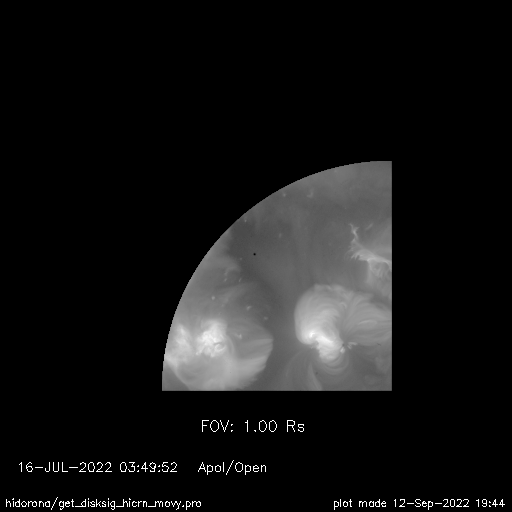 |
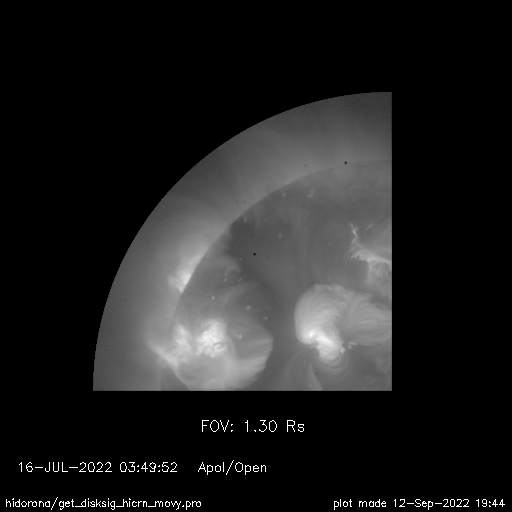 |
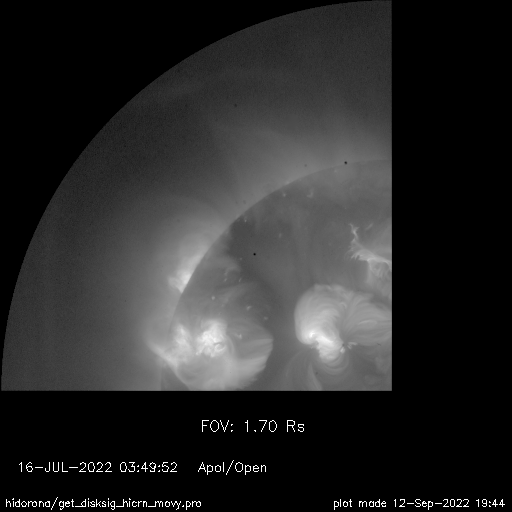 |
Total intensity of the corona included in the varying size of FOV.
[click image to enlarge]
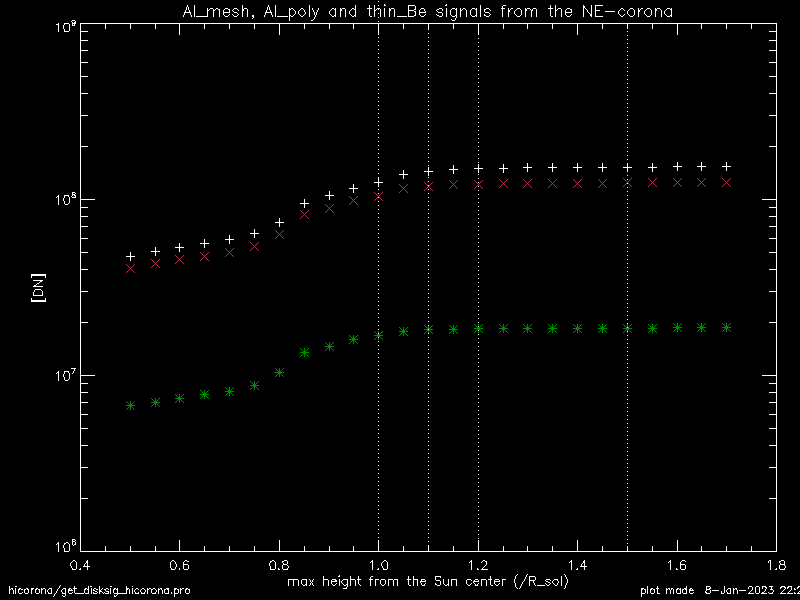 |
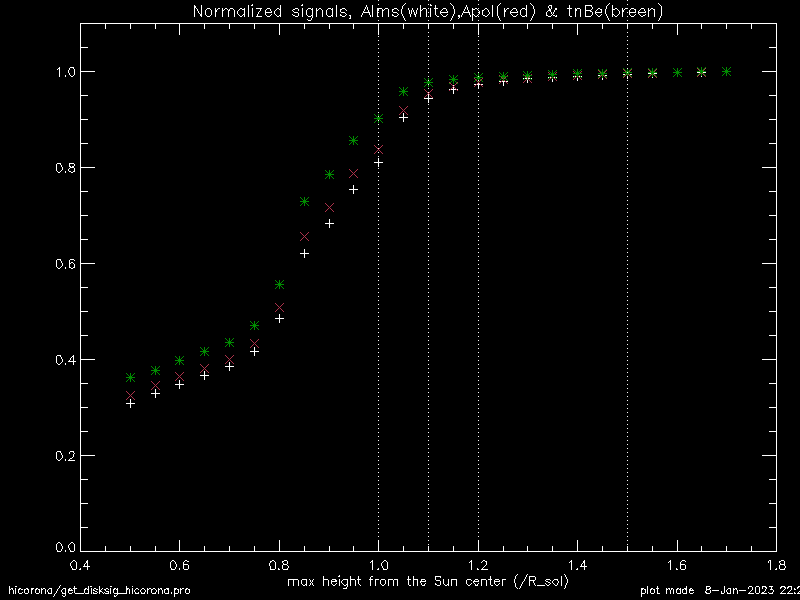 |
The ratio of the collected intensities by the FOV size, 1.0, 1.1, 1.2 and 1.3 Rs relative to the maxmum size (1.7 Rs).
-----------------------------------------------------------------
Filter FOV radius (in Rs)
1.0 1.1 1.2 1.5 1.7
-----------------------------------------------------------------
Al_mesh: 0.810241 0.944704 0.973690 0.994132 1.0
Al_poly: 0.837398 0.953268 0.977095 0.994941 1.0
thin_Be: 0.901706 0.976902 0.987773 0.997141 1.0
-----------------------------------------------------------------
Total intensity of the corona included in the varying size of FOV.
[click image to enlarge]
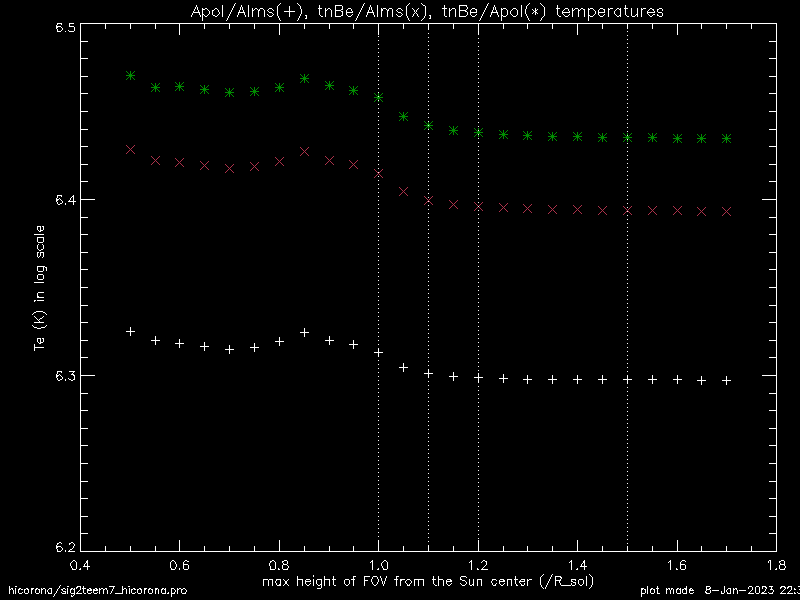 |
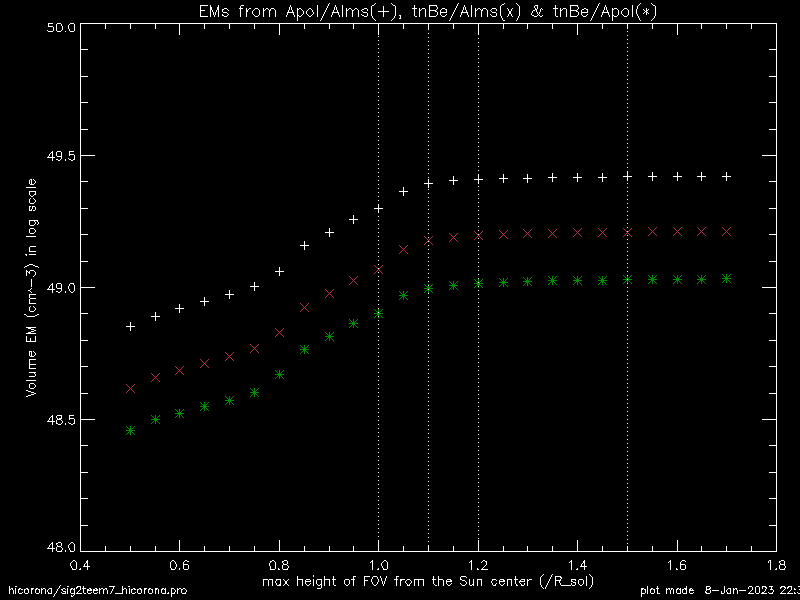 |
| results with previous calibration | results with previous calibration |
-----------------------------------------------------------------
Filter pair FOV radius (in Rs)
1.0 1.1 1.2 1.5 1.7
-----------------------------------------------------------------
Apol/Alms: 1.03637 1.00847 1.00307 1.00072 1.0
tnBe/Alms: 1.05122 1.01428 1.00604 1.00126 1.0
tnBe/Apol: 1.05492 1.01665 1.00731 1.00147 1.0
-----------------------------------------------------------------
-----------------------------------------------------------------
Filter pair FOV radius (in Rs)
1.0 1.1 1.2 1.5 1.7
-----------------------------------------------------------------
Apol/Alms: 0.752963 0.934299 0.970927 0.993478 1.0
tnBe/Alms: 0.716275 0.923520 0.964119 0.992047 1.0
tnBe/Apol: 0.738689 0.919990 0.961549 0.991664 1.0
-----------------------------------------------------------------
Soft X-ray irradiance calculatded for the varying size of FOV.
[click image to enlarge]
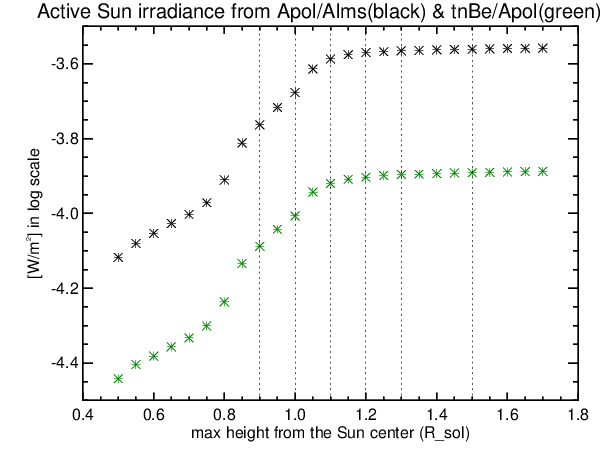 |
| with previous calibration |
The ratio of the XRT irradiance (5-60A) calculated for the FOV size, 1.0 to 1.5 Rs relative to that for the maxmum size (1.7 Rs).
-----------------------------------------------------------------
Filter pair FOV radius (in Rs)
1.0 1.1 1.2 1.5 1.7
-----------------------------------------------------------------
Apol/Alms: 0.764553 0.937850 0.974617 0.997254 1.0
tnBe/Alms: 0.731757 0.928466 0.964119 0.992047 1.0
tnBe/Apol: 0.762626 0.925620 0.967432 0.991664 1.0
-----------------------------------------------------------------
-----------------------------------------------------------------
Filter pair FOV radius (in Rs)
1.0 1.1 1.2 1.5 1.7
-----------------------------------------------------------------
Apol/Alms: 0.784465 0.962275 1.0 --- ---
tnBe/Alms: 0.758990 0.963020 1.0 --- ---
tnBe/Apol: 0.788299 0.956780 1.0 --- ---
-----------------------------------------------------------------
| XOB#16F4 for 9-filter synoptic program. [click to enlarge] |
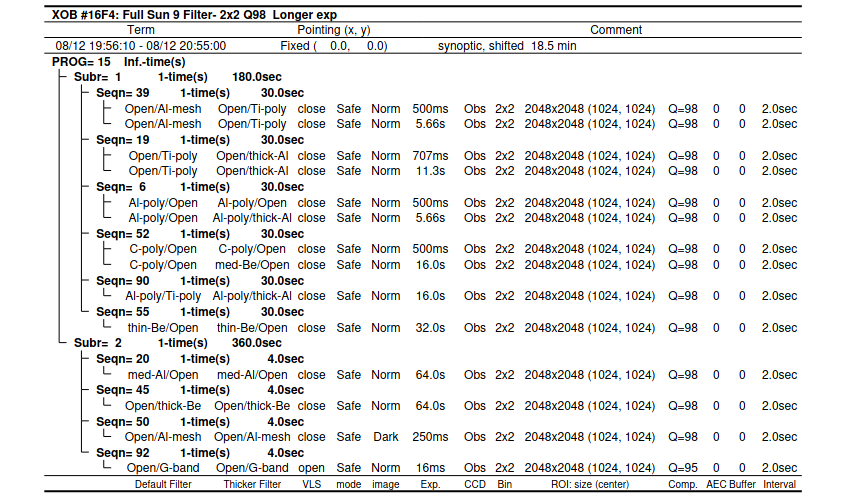
|
[click image to enlarge]
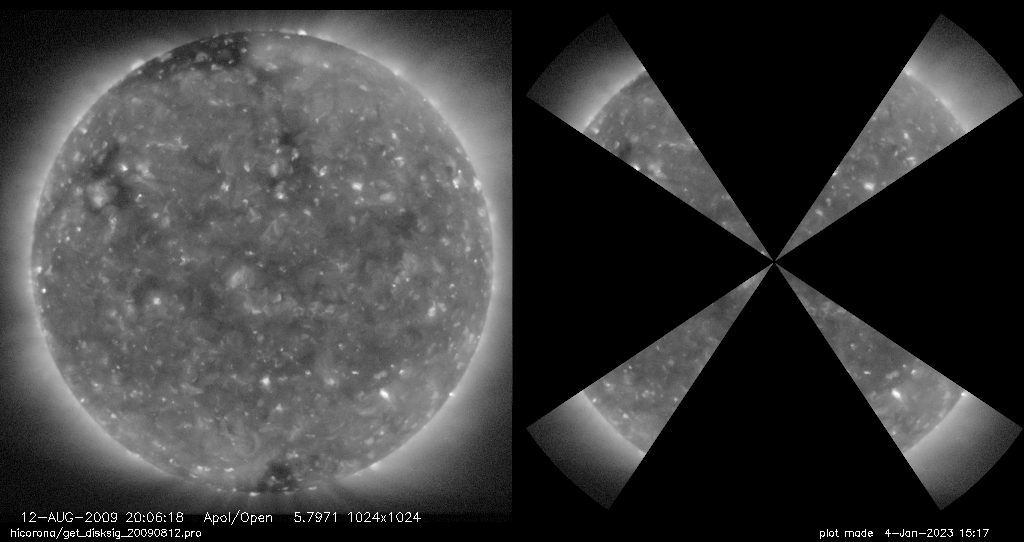 |
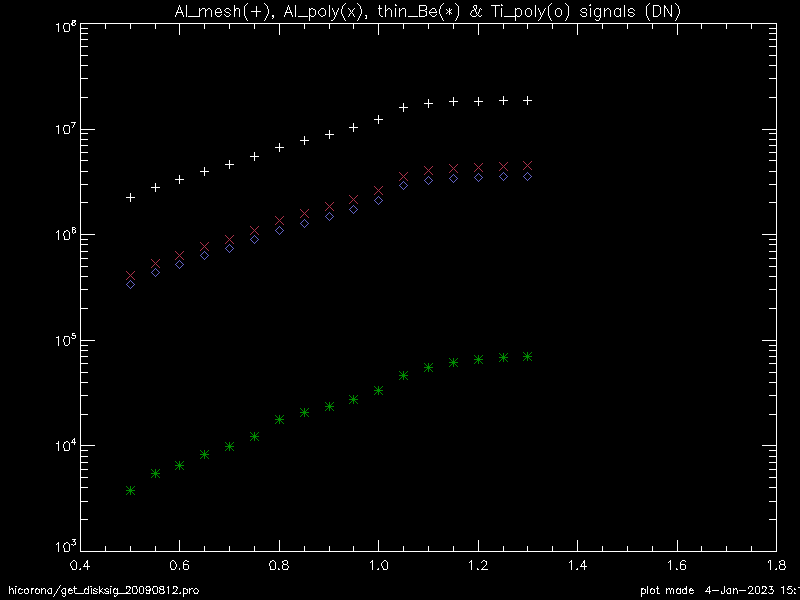 |
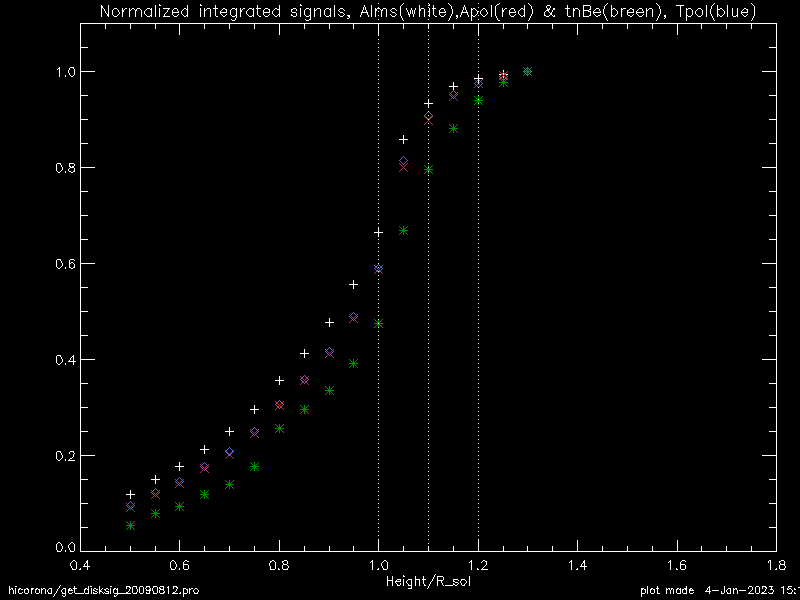 |
The XRT intensities included in the 4-leafed FOV size, 1.0, 1.1 & 1.2 relative to that of the maxmum size (1.3 Rs).
-----------------------------------------------------------------
Filter FOV radius (in Rs)
1.0 1.1 1.2 1.3
-----------------------------------------------------------------
Al_mesh: 0.665005 0.934206 0.984892 1.0
Al_poly: 0.586943 0.897478 0.975144 1.0
Ti_poly: 0.589932 0.907299 0.975487 1.0
thin_Be: 0.475370 0.795194 0.939882 1.0
-----------------------------------------------------------------
| minimum corona | active corona |
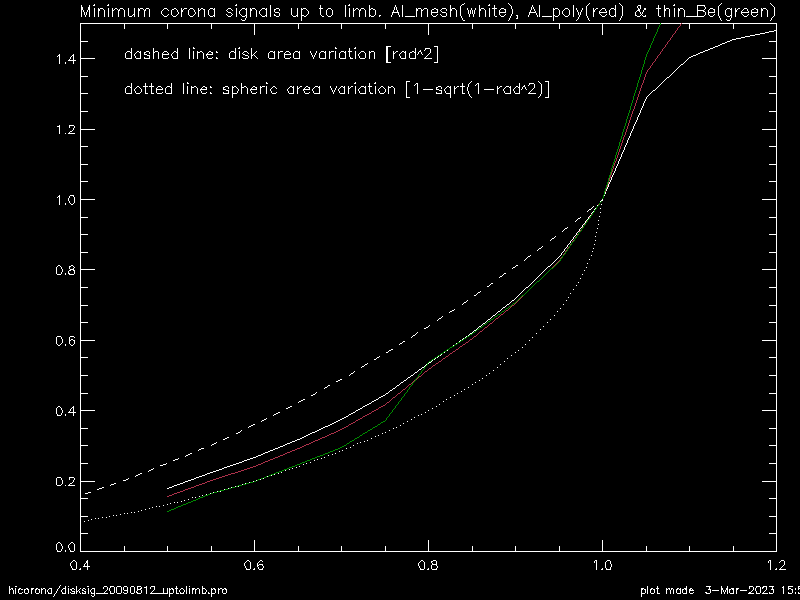 |
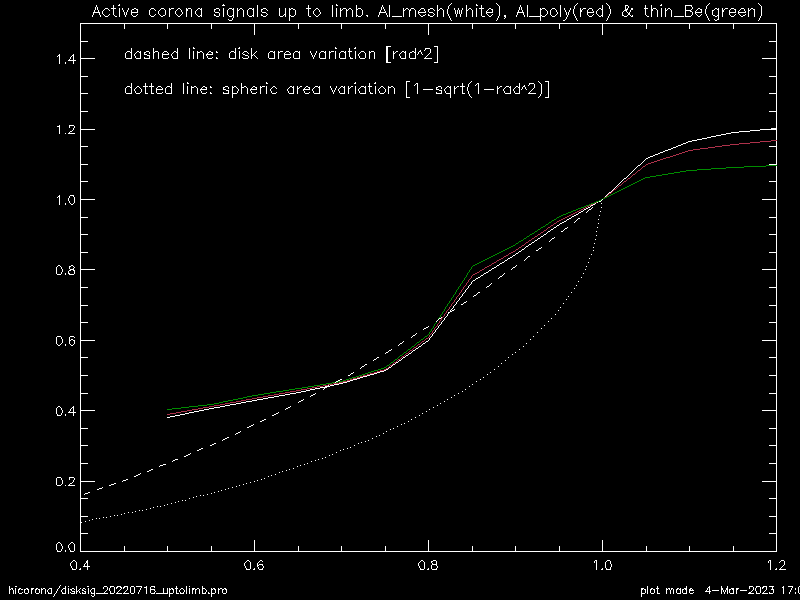 |
| minimum corona : signal plot (DN) |
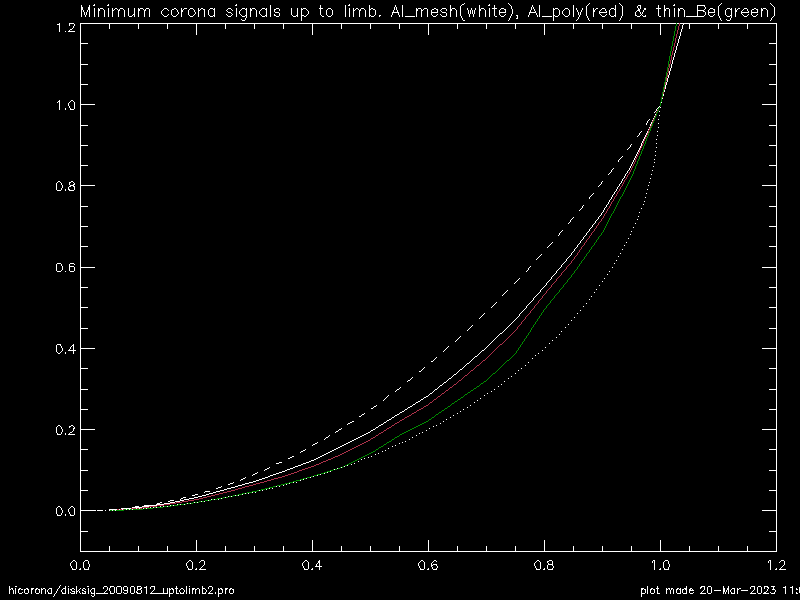 |
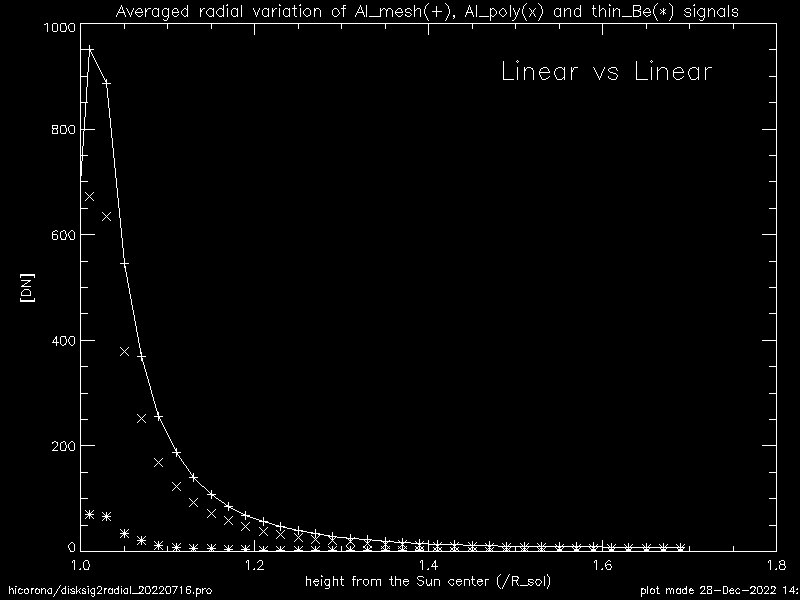 |
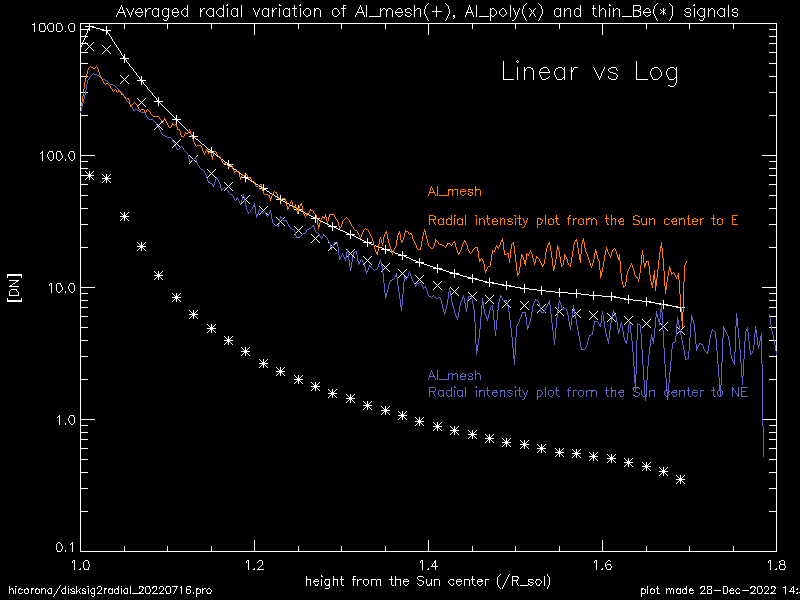 |
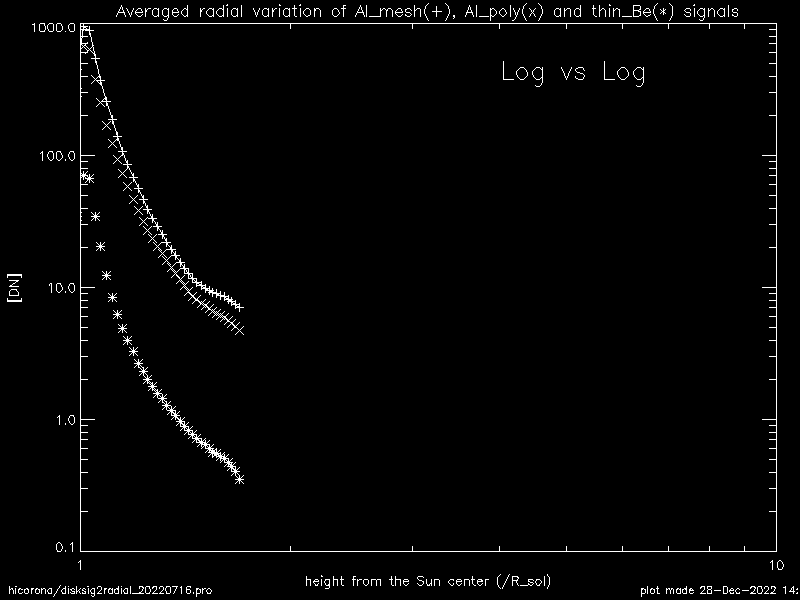 |
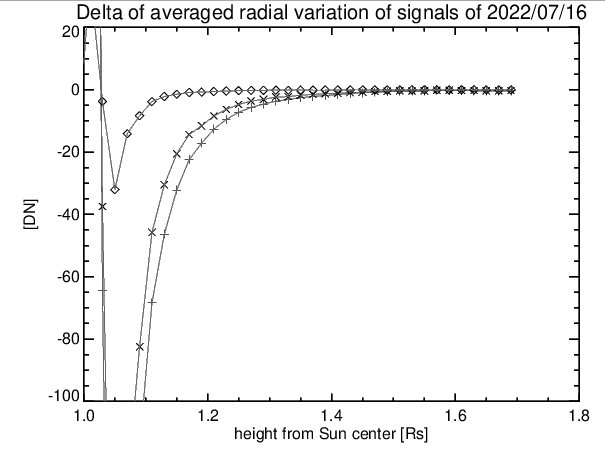 |
In order to get high S/N, two images taken 9 min apart with the same filter were added and normalized with exposures(1 sec).
Al_mesh image : ([image at 20:05:18] + [image at 20:14:18]) * 0.5 Ti_poly image : ([image at 20:05:47] + [image at 20:14:47]) * 0.5 Al_poly image : ([image at 20:06:18] + [image at 20:15:18]) * 0.5 Thin_Be image : ([image at 20:07:44] + [image at 20:16:44]) * 0.5[click image to enlarge]
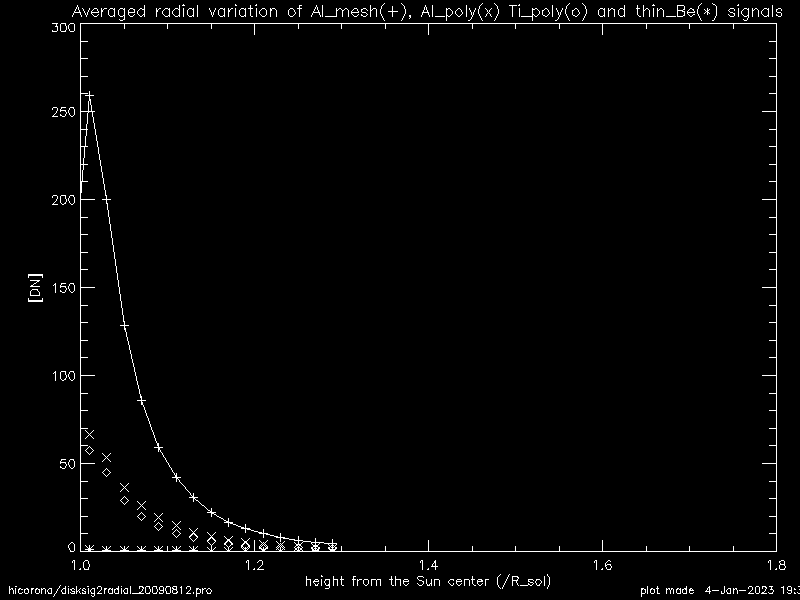 |
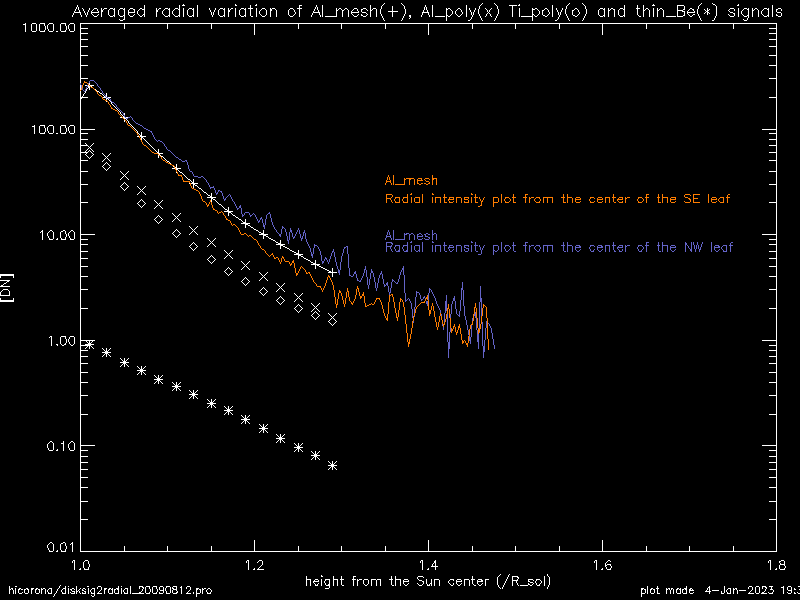 |
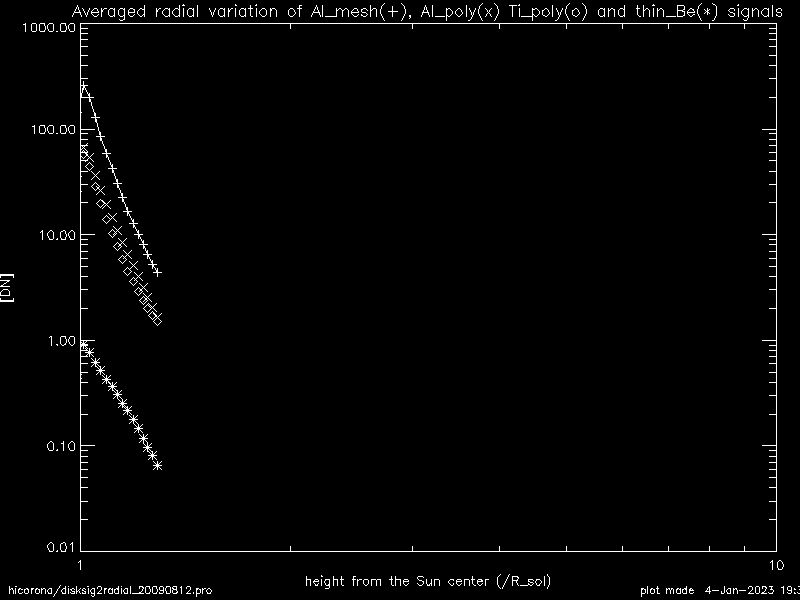 |
| Intensity decreasing rate <1.29 : observed >1.31 : assumed as reaching zero at 1.43 Rs (Alms & Tpol) and 1.41 Rs (Apol & tnBe) |
Radial intensity variation <1.29 : observed >1.31 : calculated |
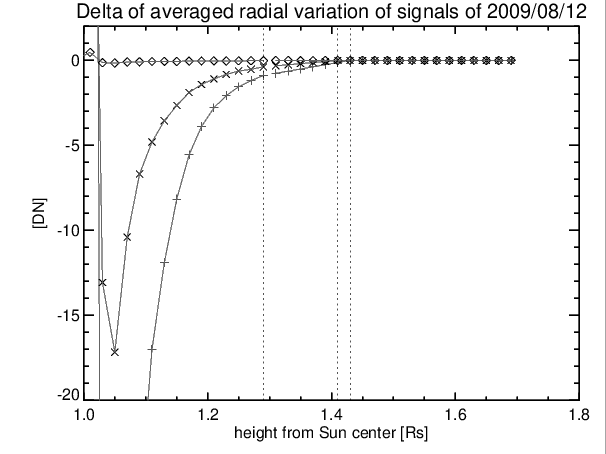 |
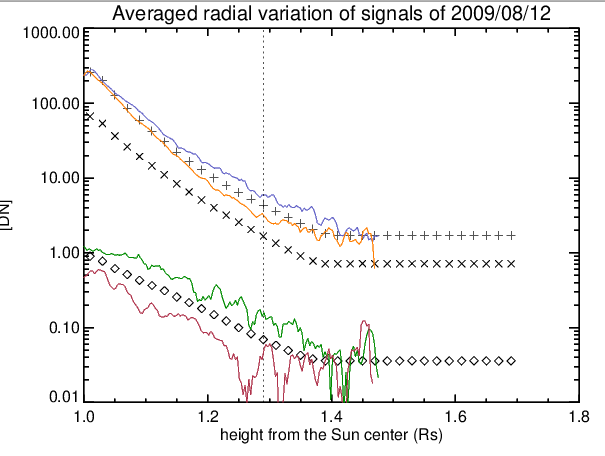 |
| height ≤ 1.30 : observed height > 1.30 : calculated |
Normalized values relative to 1.7Rs |
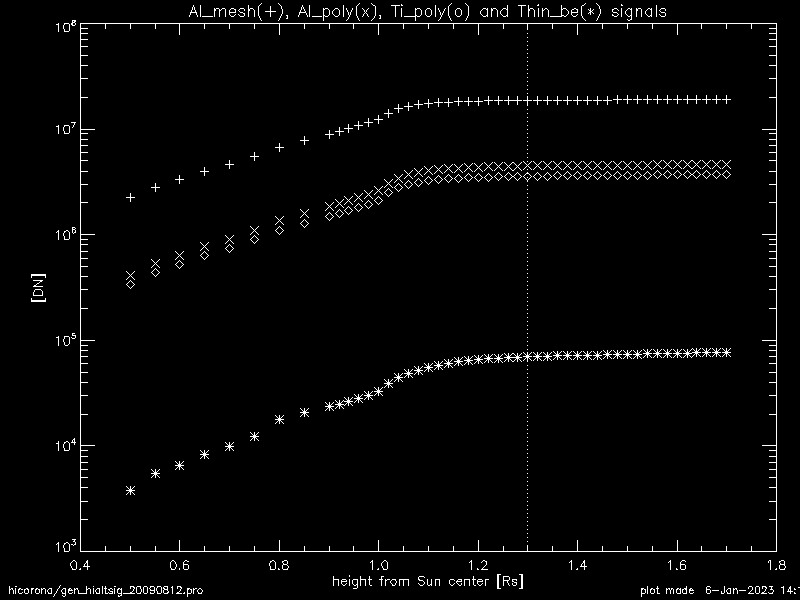 |
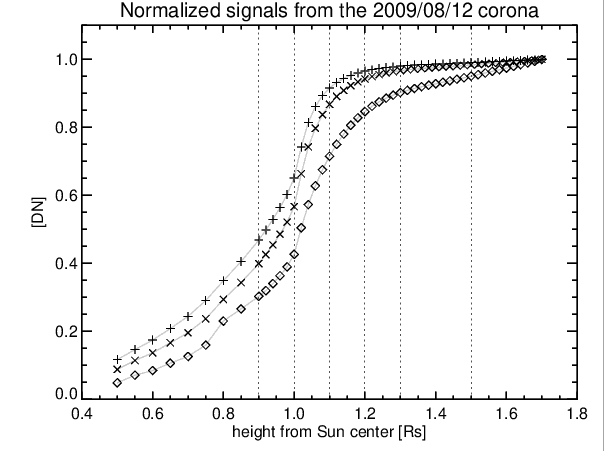 |
-----------------------------------------------------------------
Filter FOV radius (in Rs)
1.0 1.1 1.2 1.5 1.7
-----------------------------------------------------------------
Alms: 0.651780 0.915831 0.965464 0.990552 1.0
Apol: 0.567166 0.867703 0.942777 0.983604 1.0
tpol: 0.562819 0.866016 0.930994 0.977041 1.0
tnBe: 0.426742 0.715409 0.846663 0.950706 1.0
-----------------------------------------------------------------
-----------------------------------------------------------------
Filter FOV radius (in Rs)
1.0 1.1 1.2 1.5 1.7
-----------------------------------------------------------------
Alms: 0.657996 0.924566 0.974673 1.00000 ---
Apol: 0.576621 0.882167 0.958493 1.00000 ---
tpol: 0.576044 0.886366 0.952871 1.00000 ---
tnBe: 0.448869 0.752503 0.890562 1.00000 ---
-----------------------------------------------------------------
| Temperature | Emission Measure |
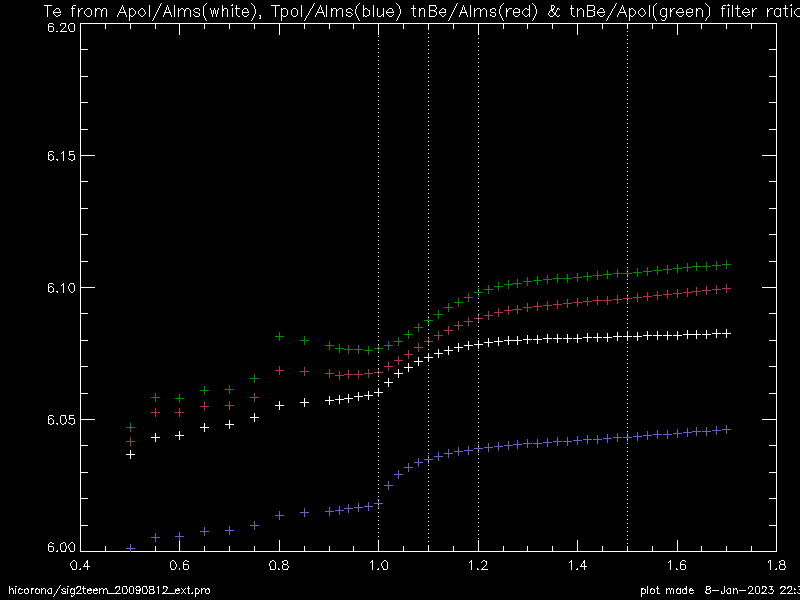 |
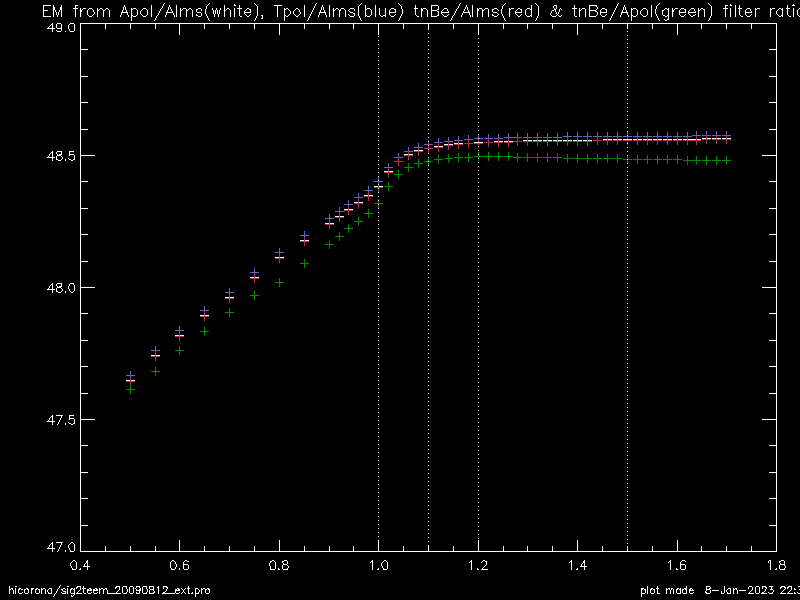 |
-----------------------------------------------------------------
Filter FOV radius (in Rs)
1.0 1.1 1.2 1.5 1.7
-----------------------------------------------------------------
Apol/Alms: 0.949665 0.979311 0.990696 0.997214 1.0
Tpol/Alms: 0.937764 0.974717 0.983332 0.993600 1.0
tnBe/Alms: 0.929756 0.954885 0.974377 0.991551 1.0
tnBe/Apol: 0.929264 0.951737 0.975238 0.992276 1.0
-----------------------------------------------------------------
-----------------------------------------------------------------
Filter FOV radius (in Rs)
1.0 1.1 1.2 1.5 1.7
-----------------------------------------------------------------
Apol/Alms: 0.661308 0.920758 0.967708 0.991229 1.0
Tpol/Alms: 0.672302 0.926120 0.972420 0.993207 1.0
tnBe/Alms: 0.660902 0.922596 0.969018 0.991638 1.0
tnBe/Apol: 0.686637 0.995959 1.03614 1.01406 1.0
-----------------------------------------------------------------
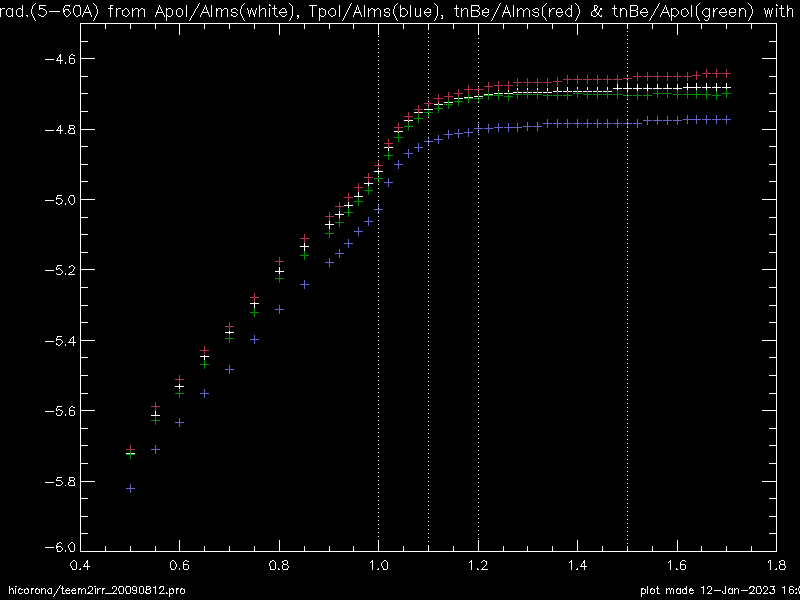 |
* Relative values to the irradiance at 1.7 Rs
-----------------------------------------------------------------
Filter FOV radius (in Rs)
1.0 1.1 1.2 1.5 1.7
-----------------------------------------------------------------
Apol/Alms: 0.57601510 0.86704576 0.93929304 0.99122868 1.0
Tpol/Alms: 0.55387923 0.86466969 0.93986849 0.97651300 1.0
tnBe/Alms: 0.54609995 0.82259213 0.90295282 0.96448415 1.0
tnBe/Apol: 0.57174437 0.87978334 0.96878834 0.98767758 1.0
-----------------------------------------------------------------
* Relative values to the irradiance at 1.5 Rs
-----------------------------------------------------------------
Filter FOV radius (in Rs)
1.0 1.1 1.2 1.5 1.7
-----------------------------------------------------------------
Apol/Alms: 0.58111222 0.87471820 0.94760479 1.0 ---
Tpol/Alms: 0.56720108 0.88546664 0.96247412 1.0 ---
tnBe/Alms: 0.56620936 0.85288300 0.93620286 1.0 ---
tnBe/Apol: 0.57887754 0.89075965 0.98087510 1.0 ---
-----------------------------------------------------------------
* Relative values to the irradiance at 1.2 Rs
-----------------------------------------------------------------
Filter FOV radius (in Rs)
1.0 1.1 1.2 1.5 1.7
-----------------------------------------------------------------
Apol/Alms: 0.61324324 0.92308336 1.0 --- ---
Tpol/Alms: 0.58931566 0.91999006 1.0 --- ---
tnBe/Alms: 0.60479347 0.91100237 1.0 --- ---
tnBe/Apol: 0.59016439 0.90812752 1.0 --- ---
-----------------------------------------------------------------